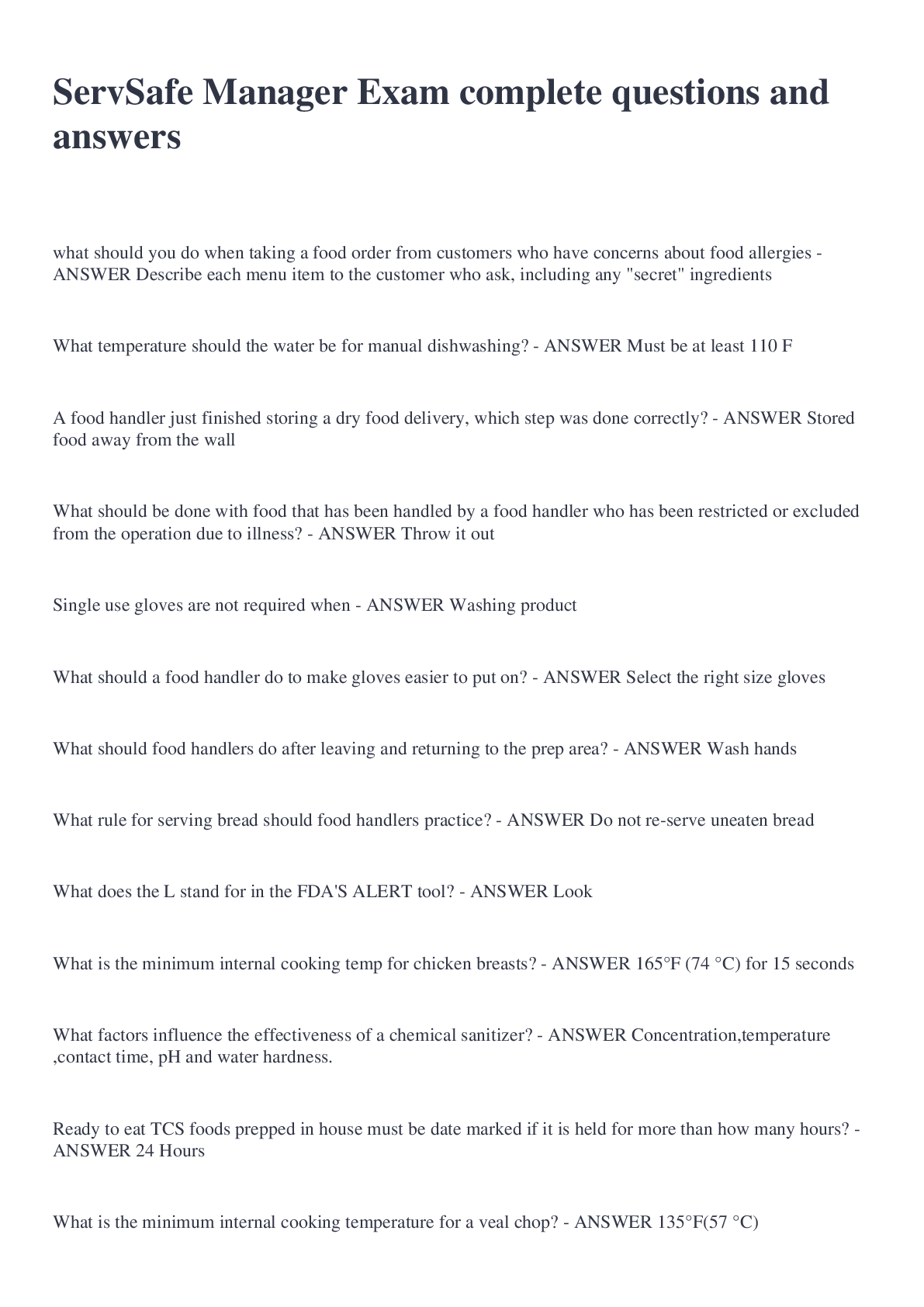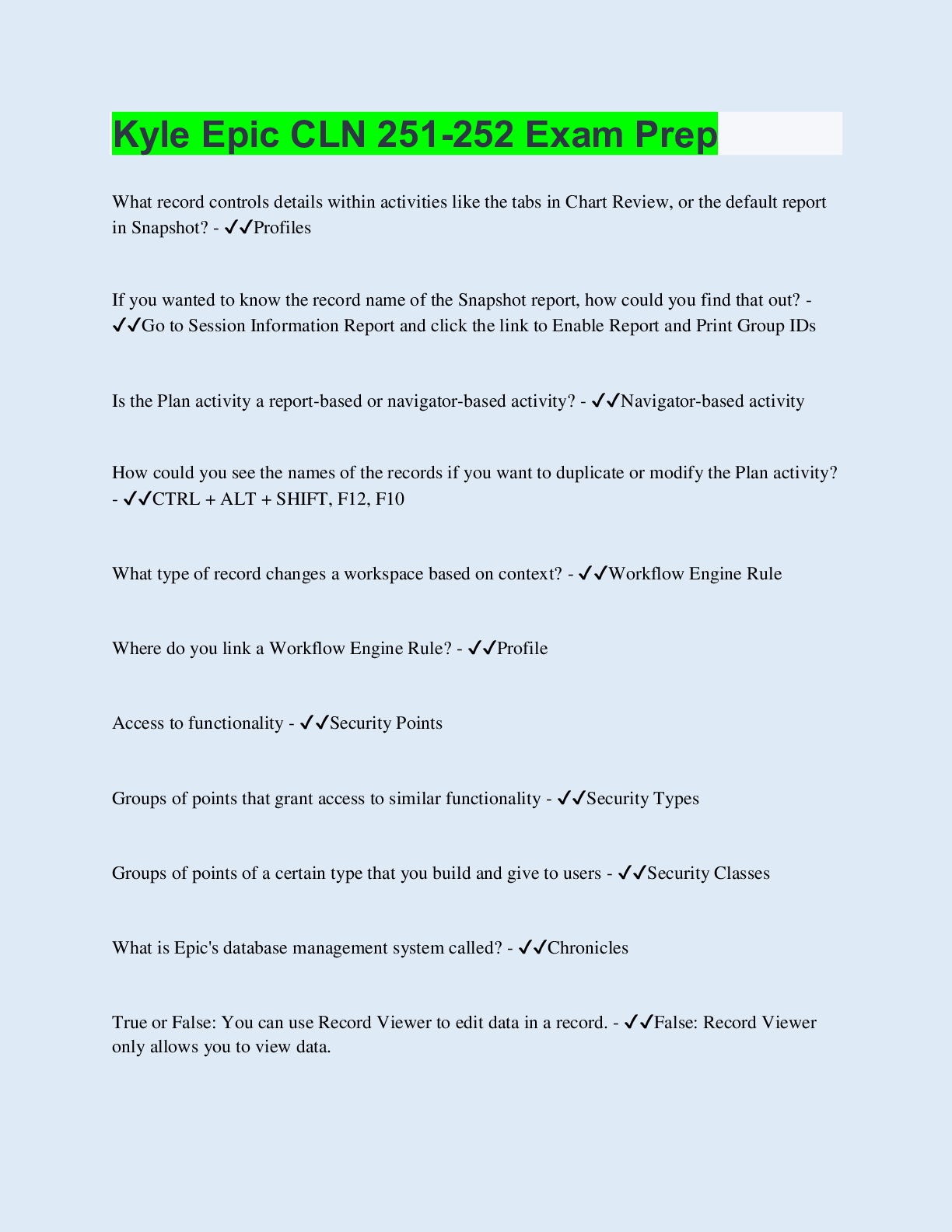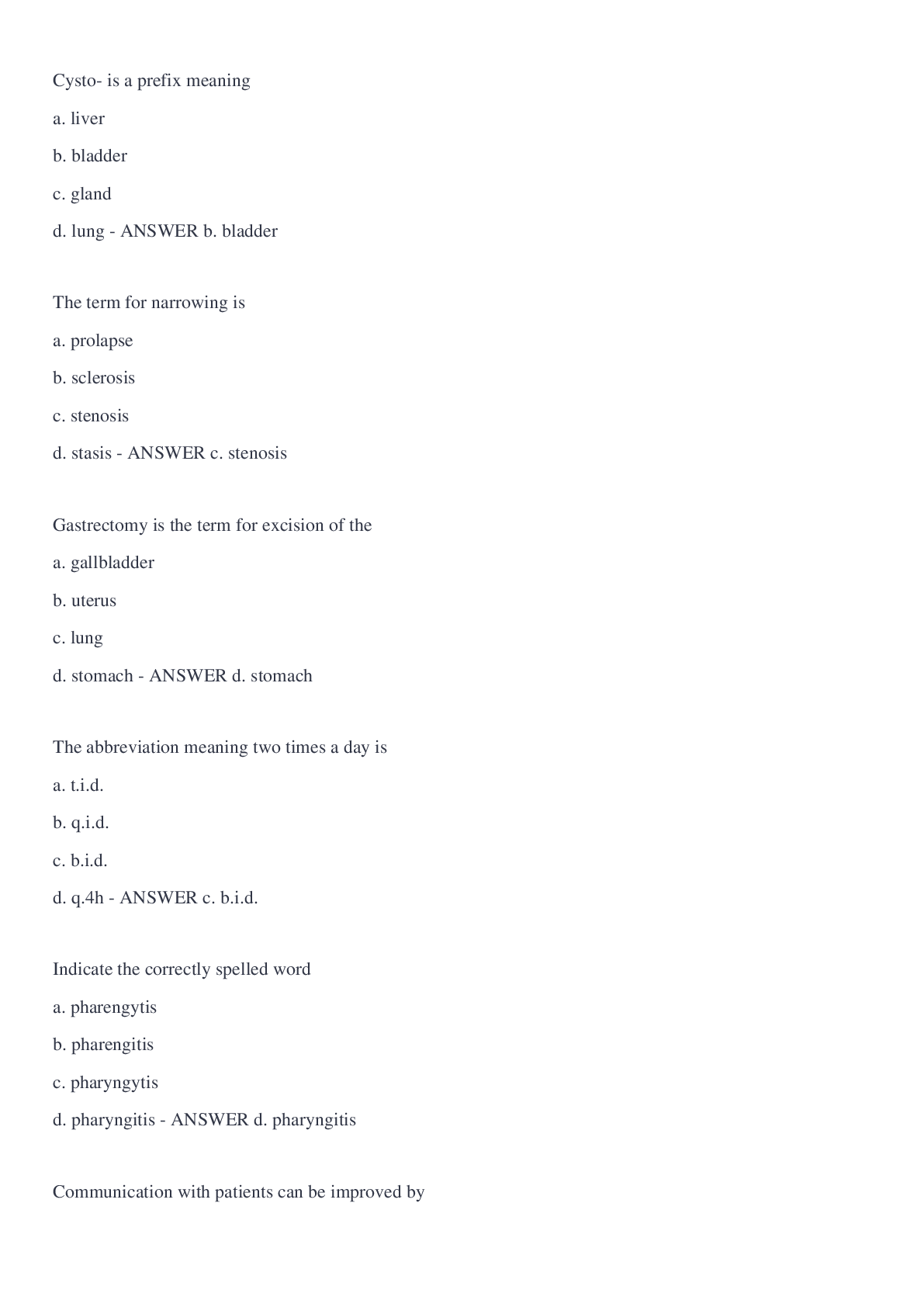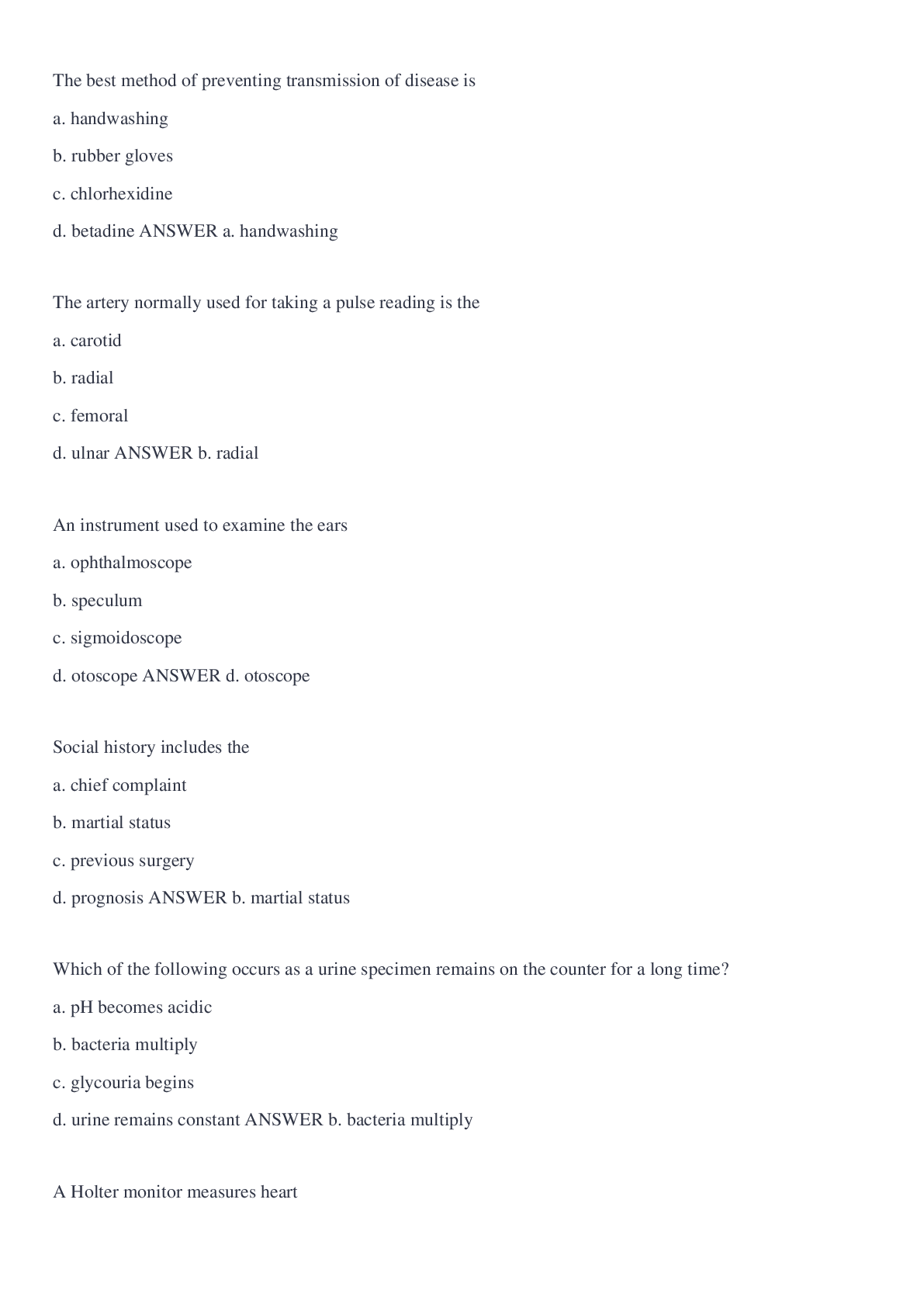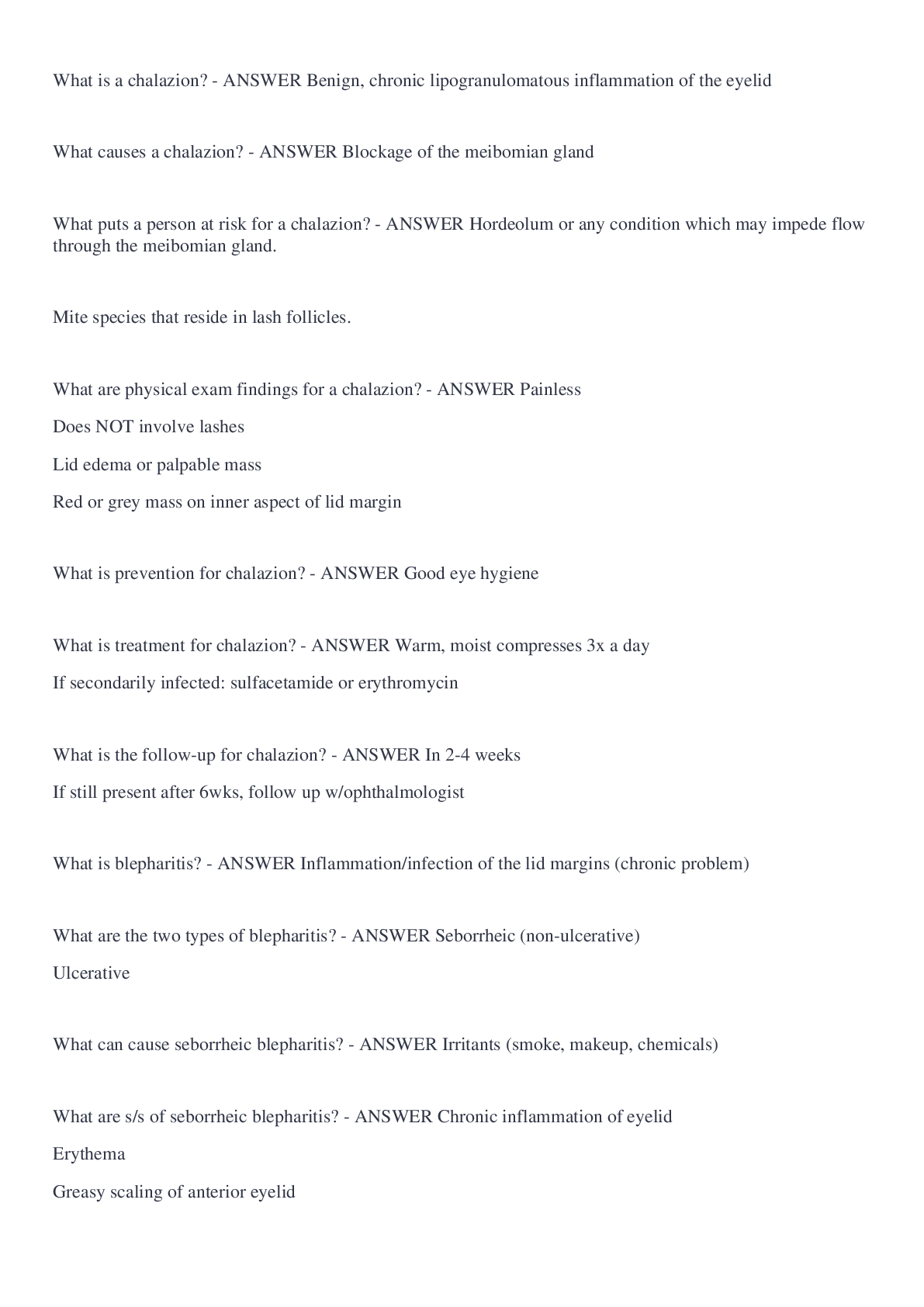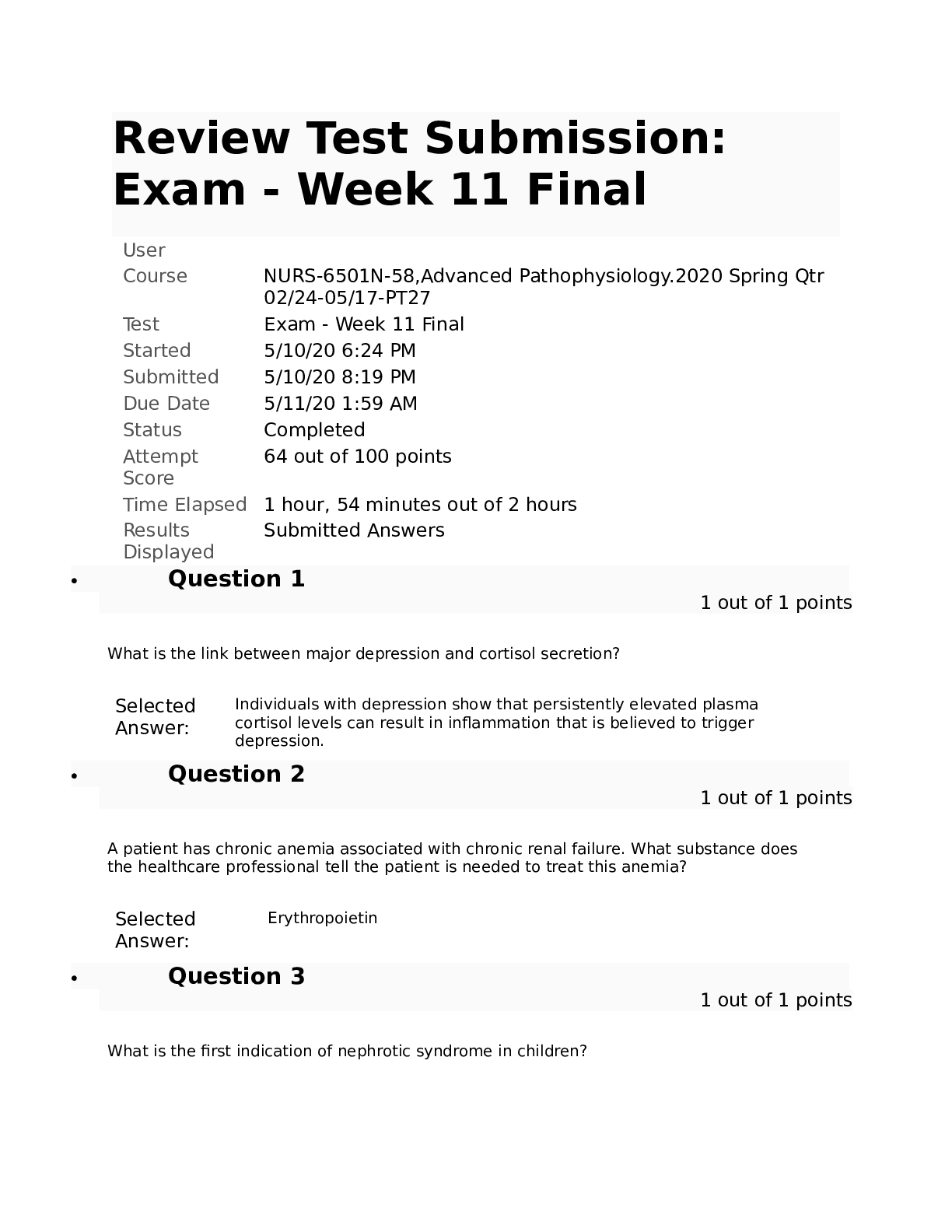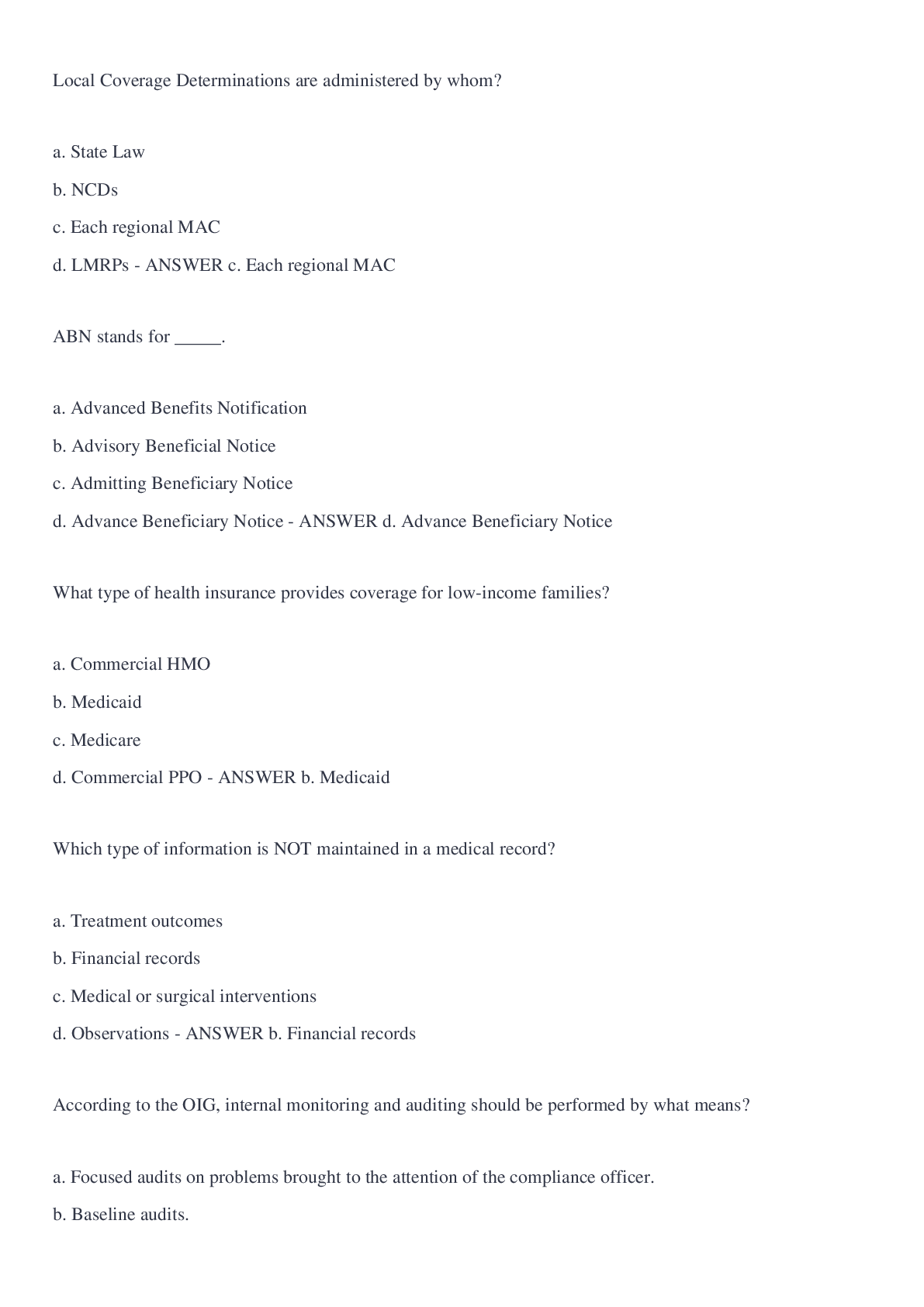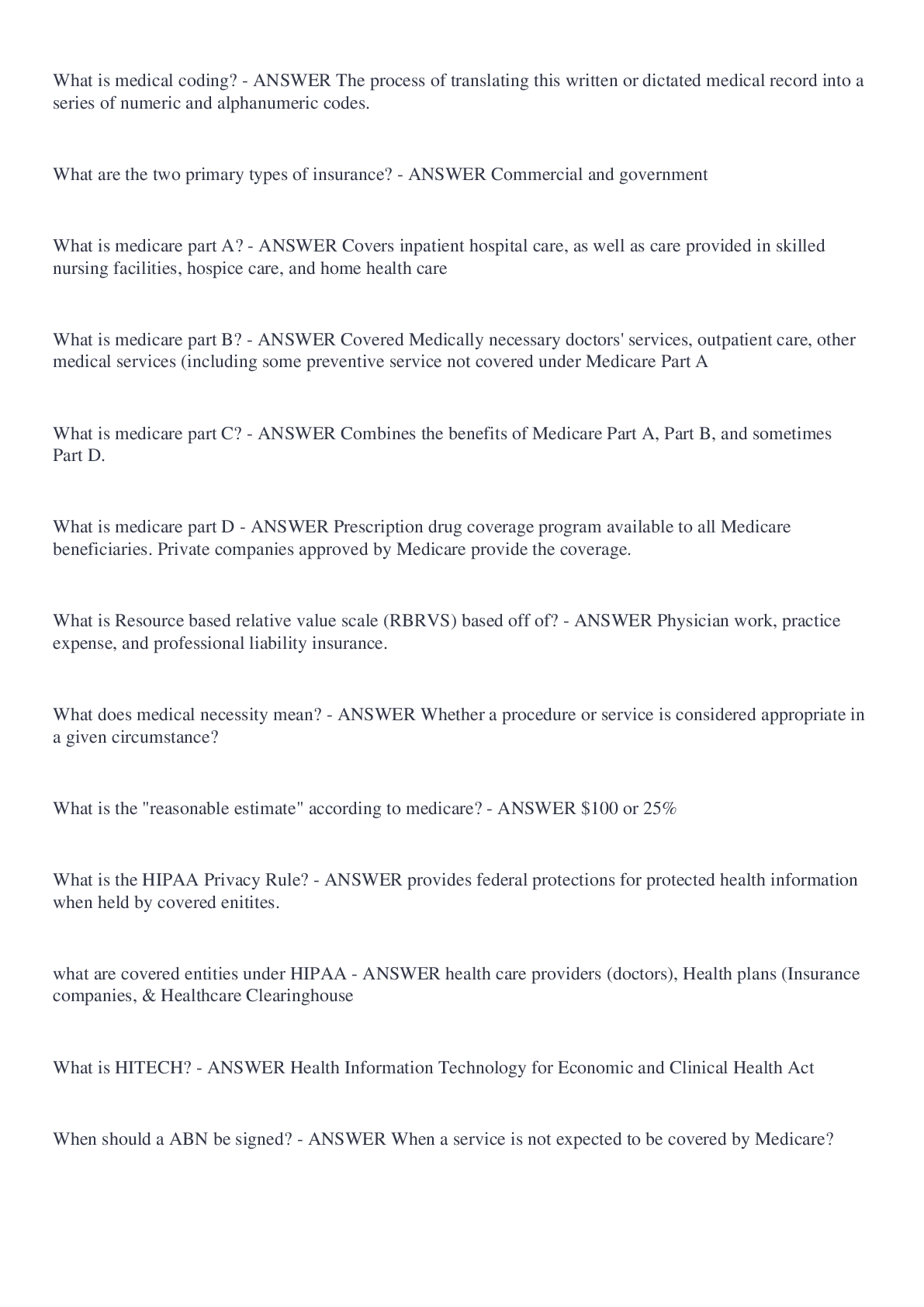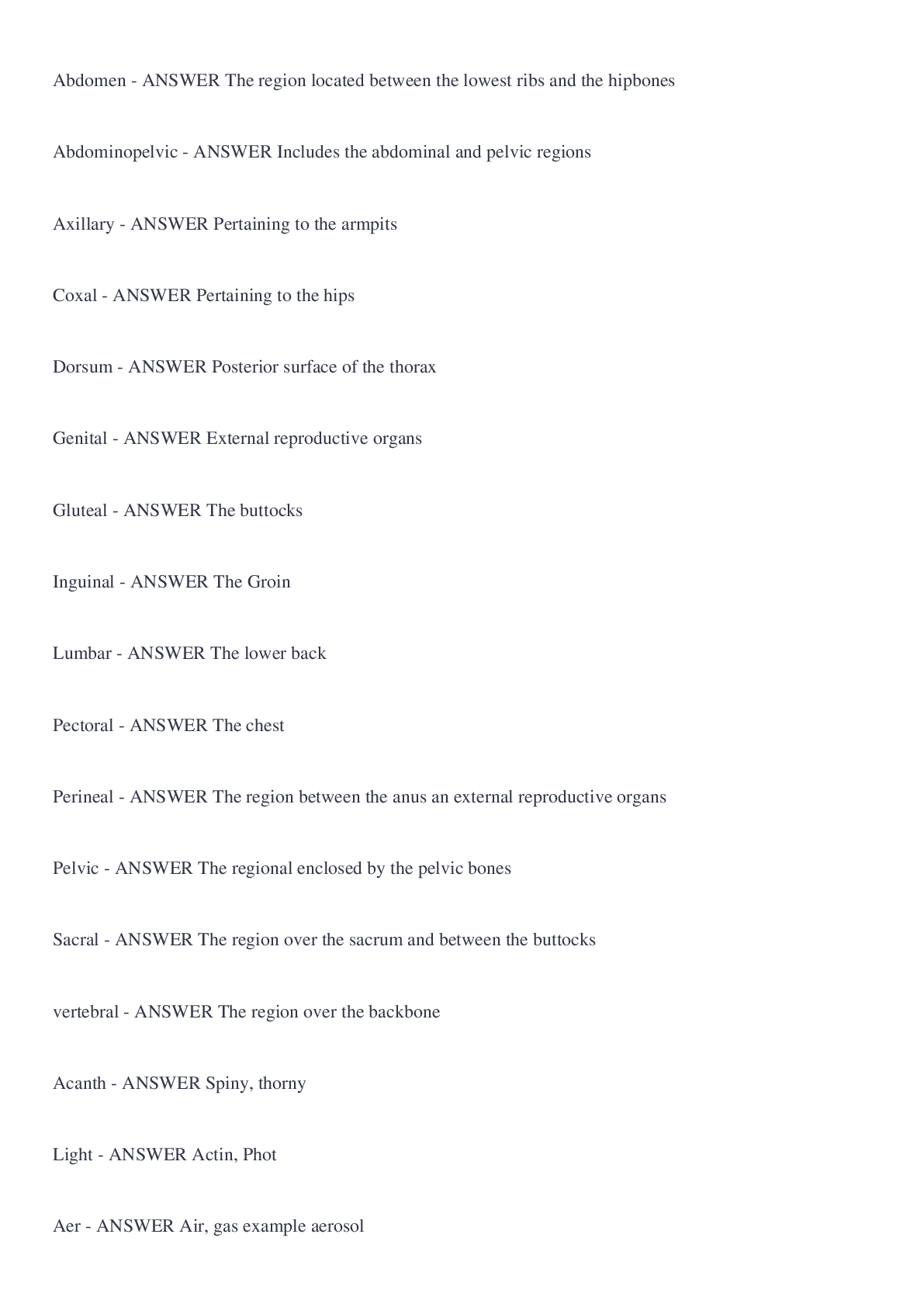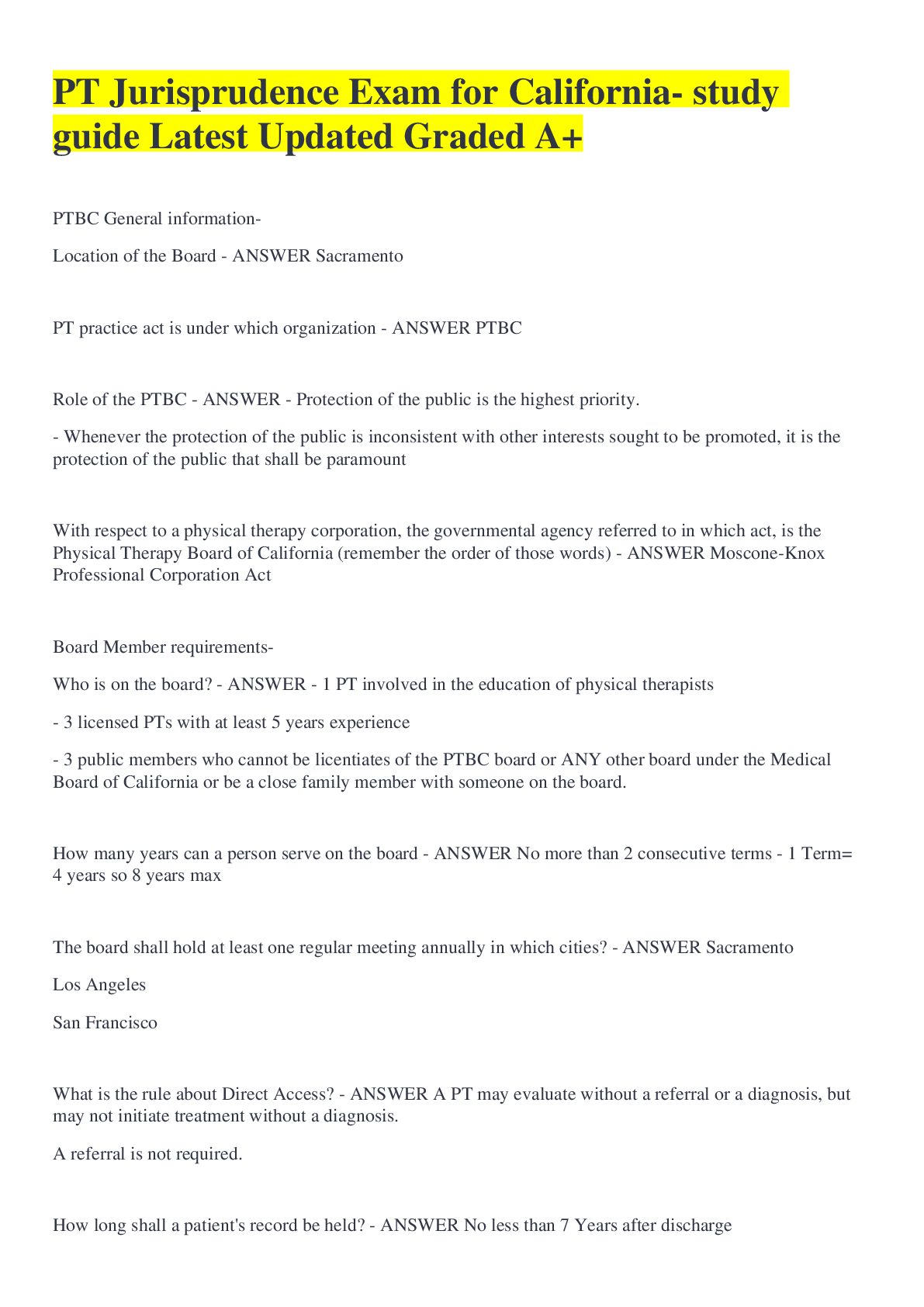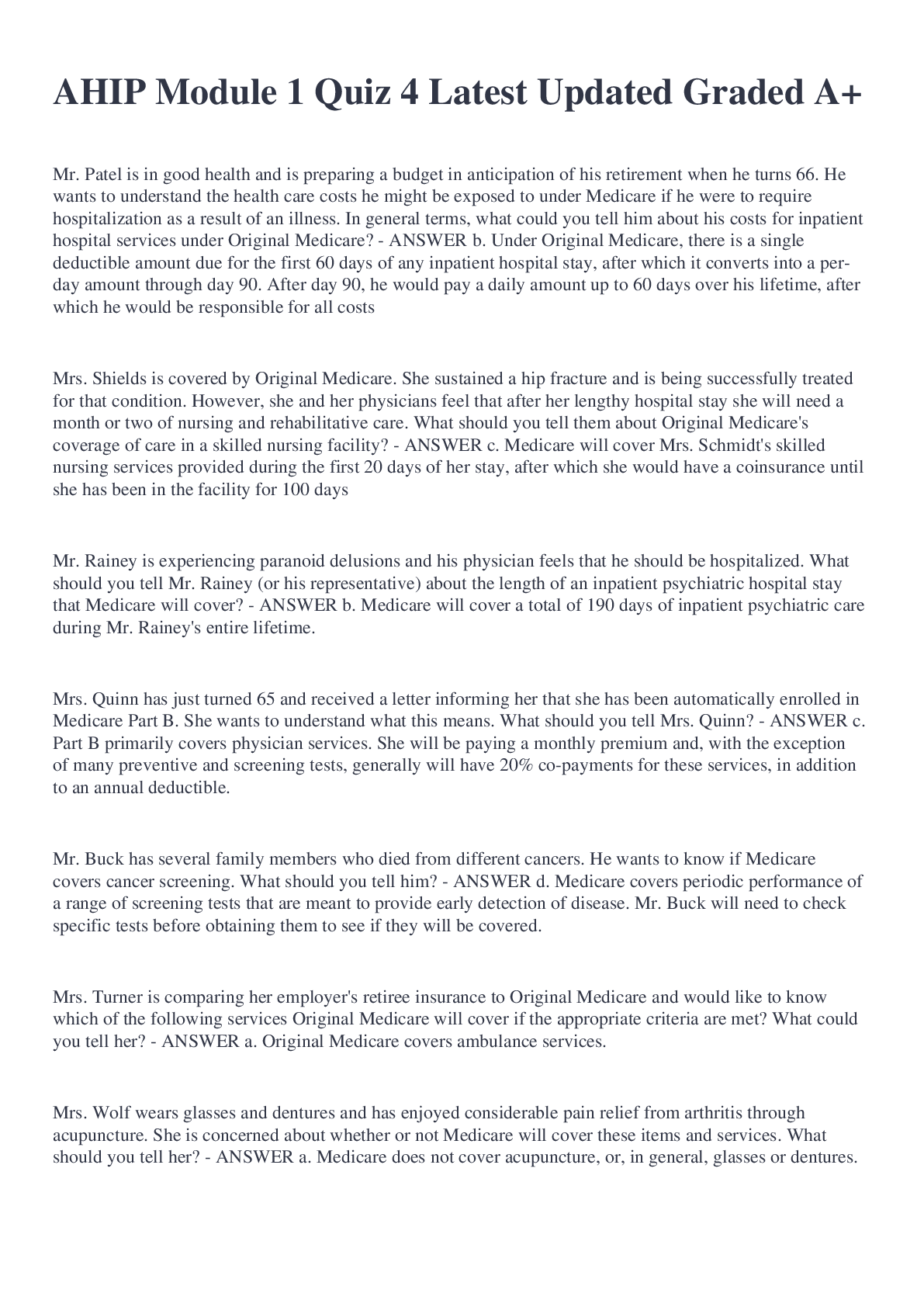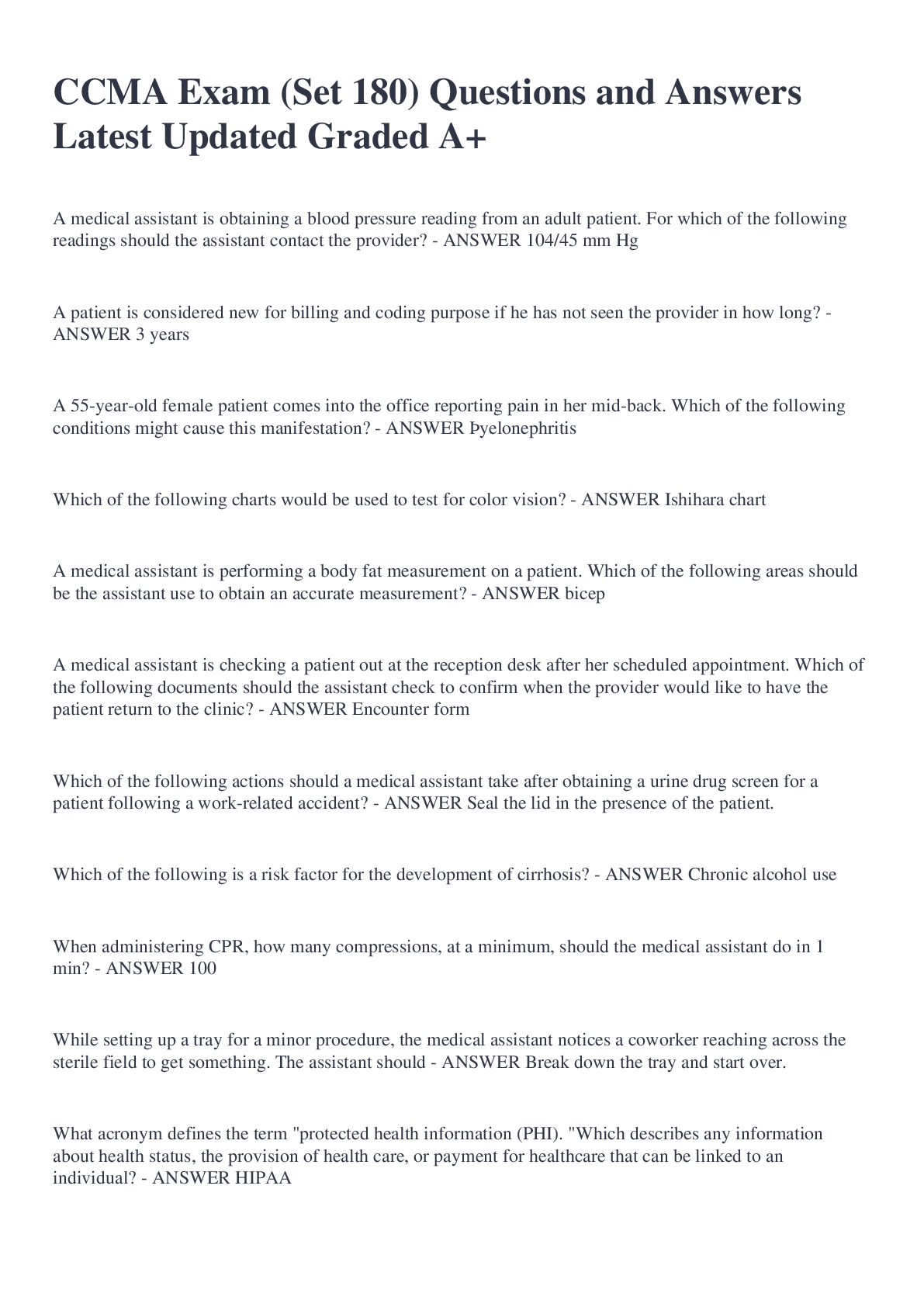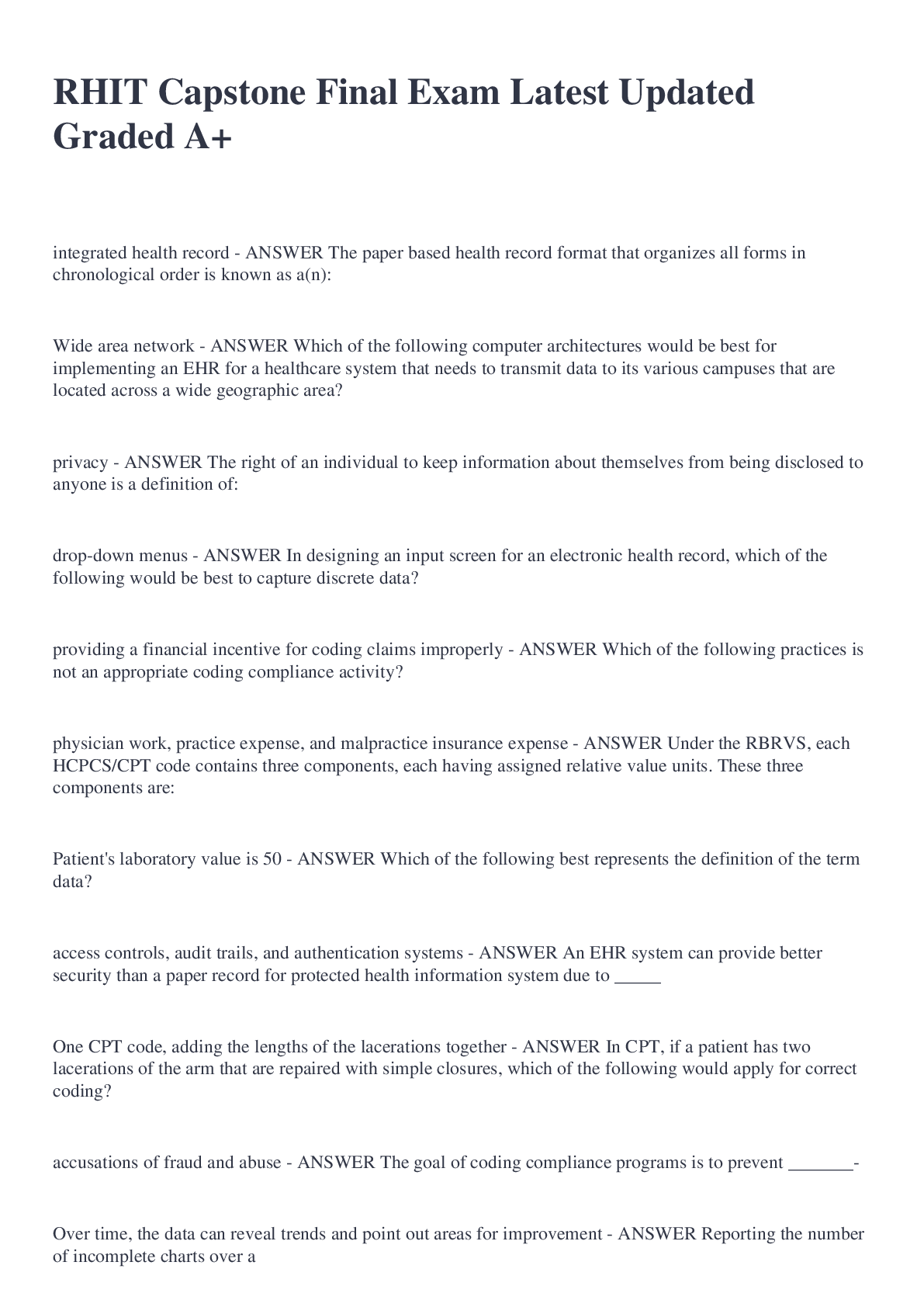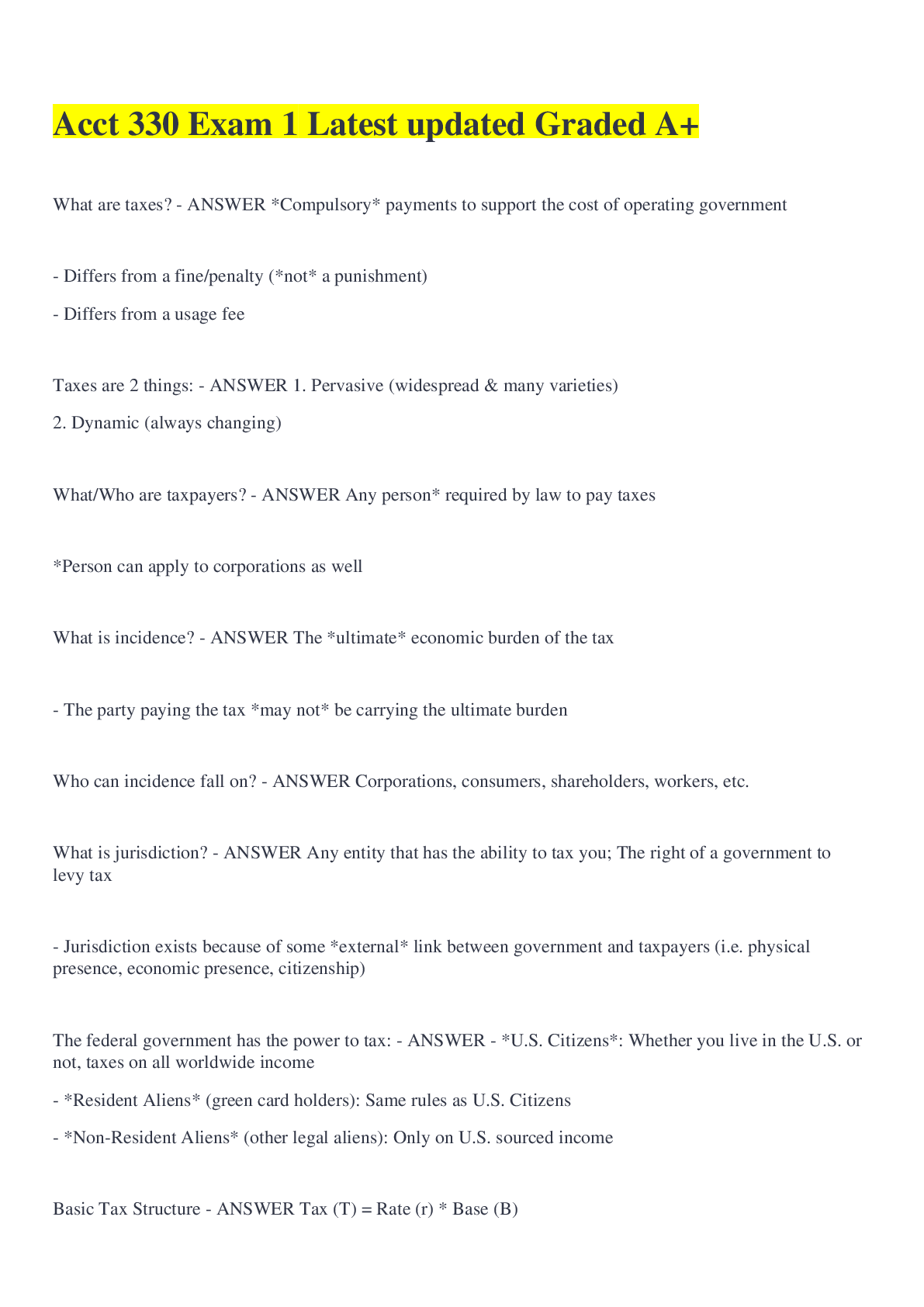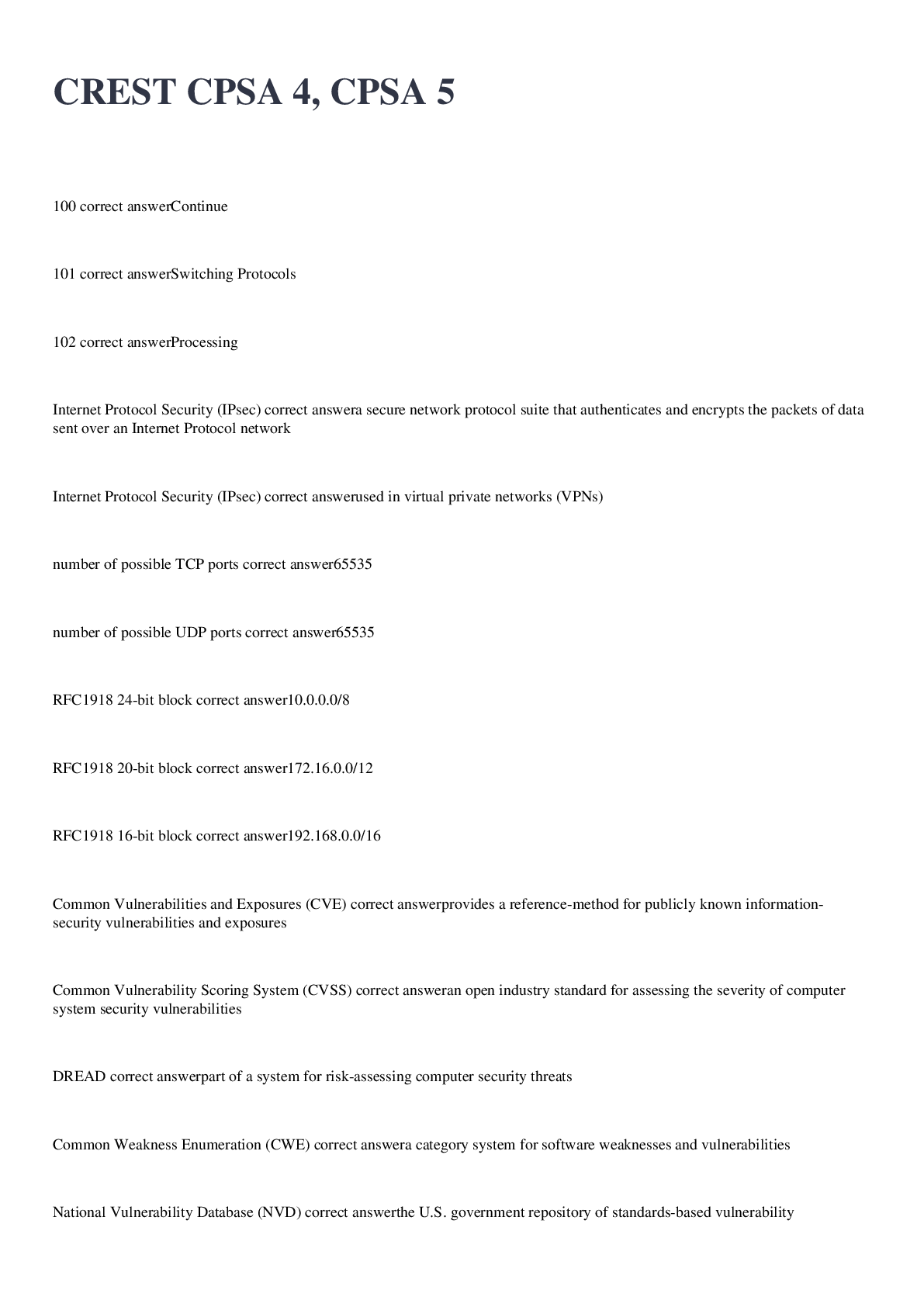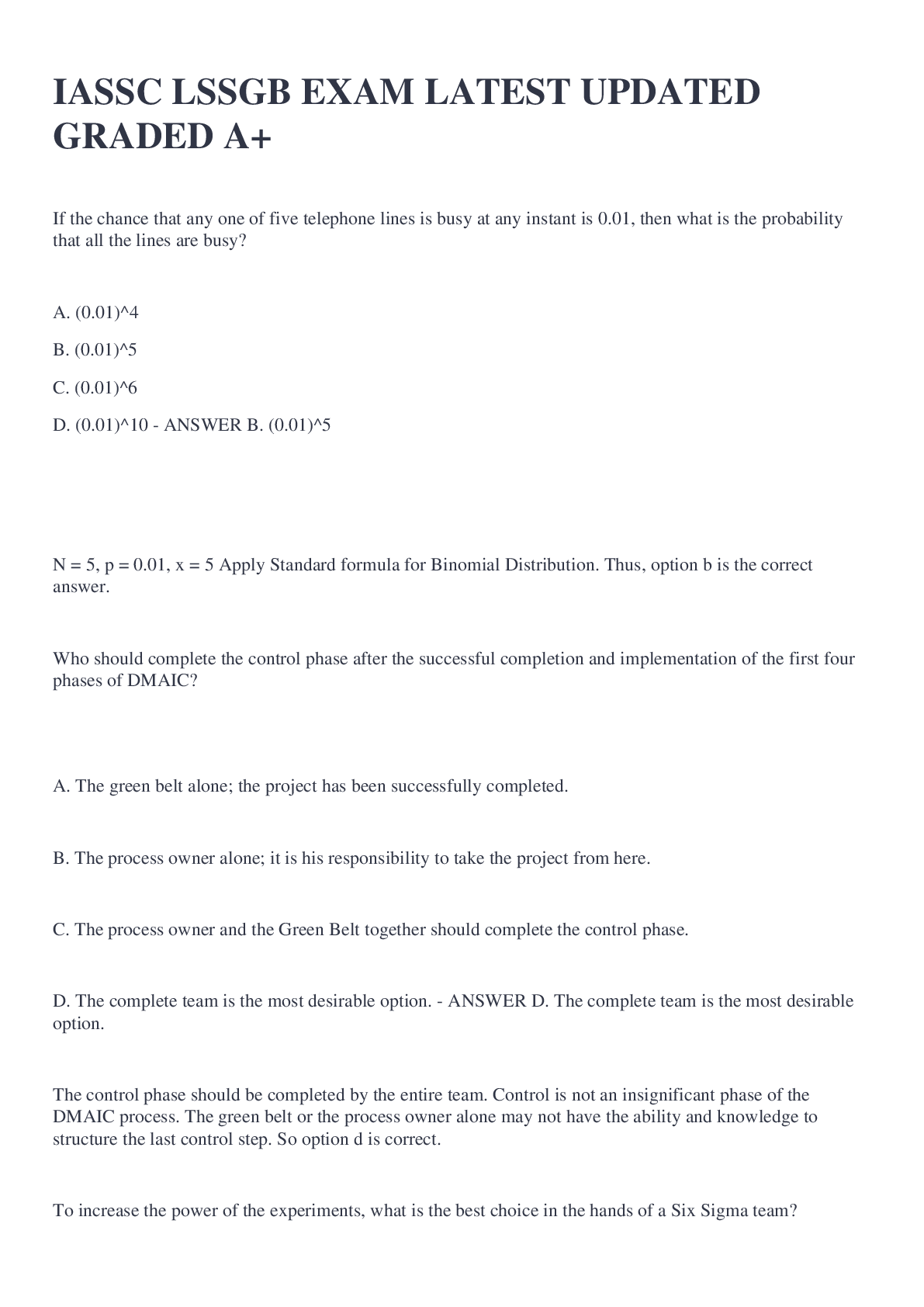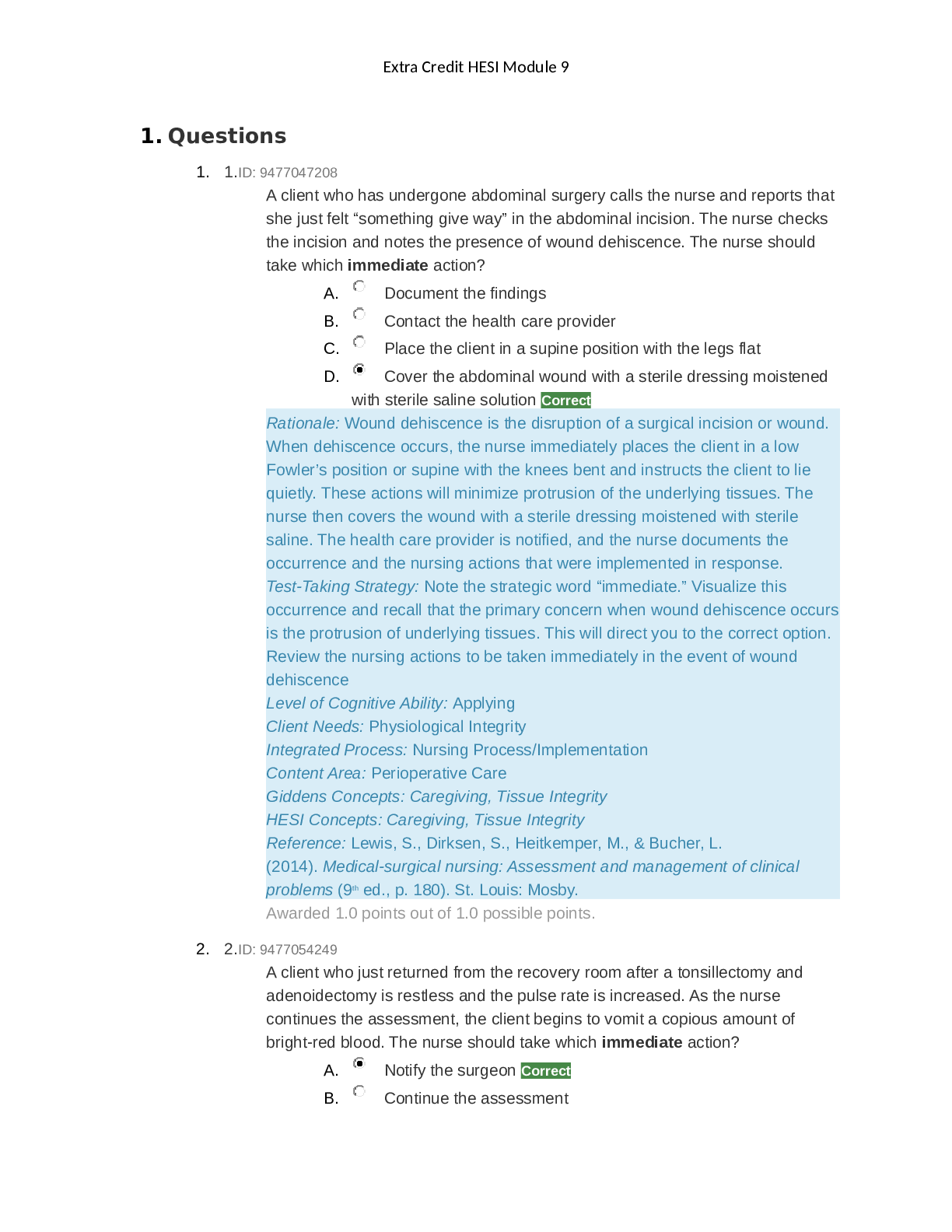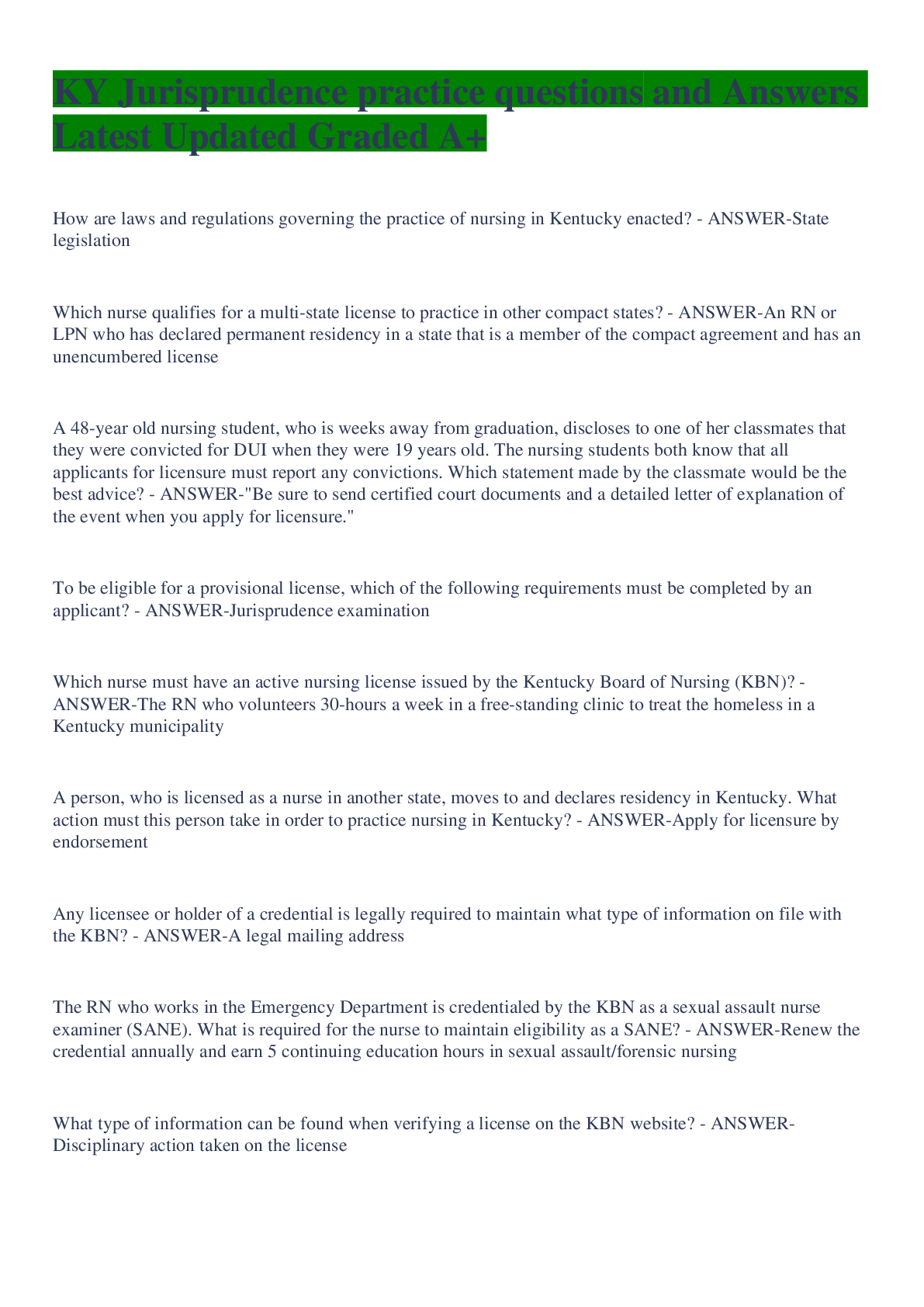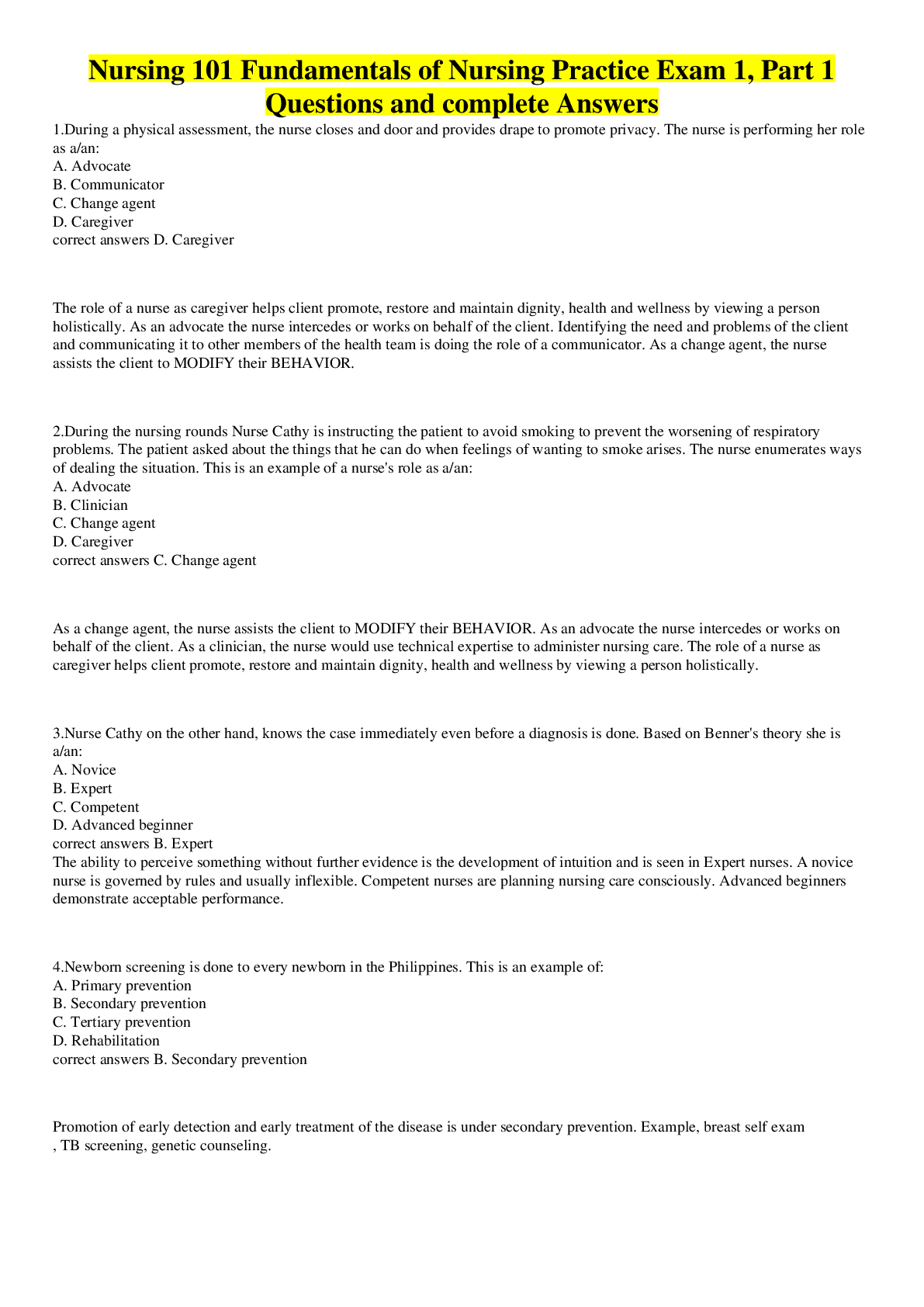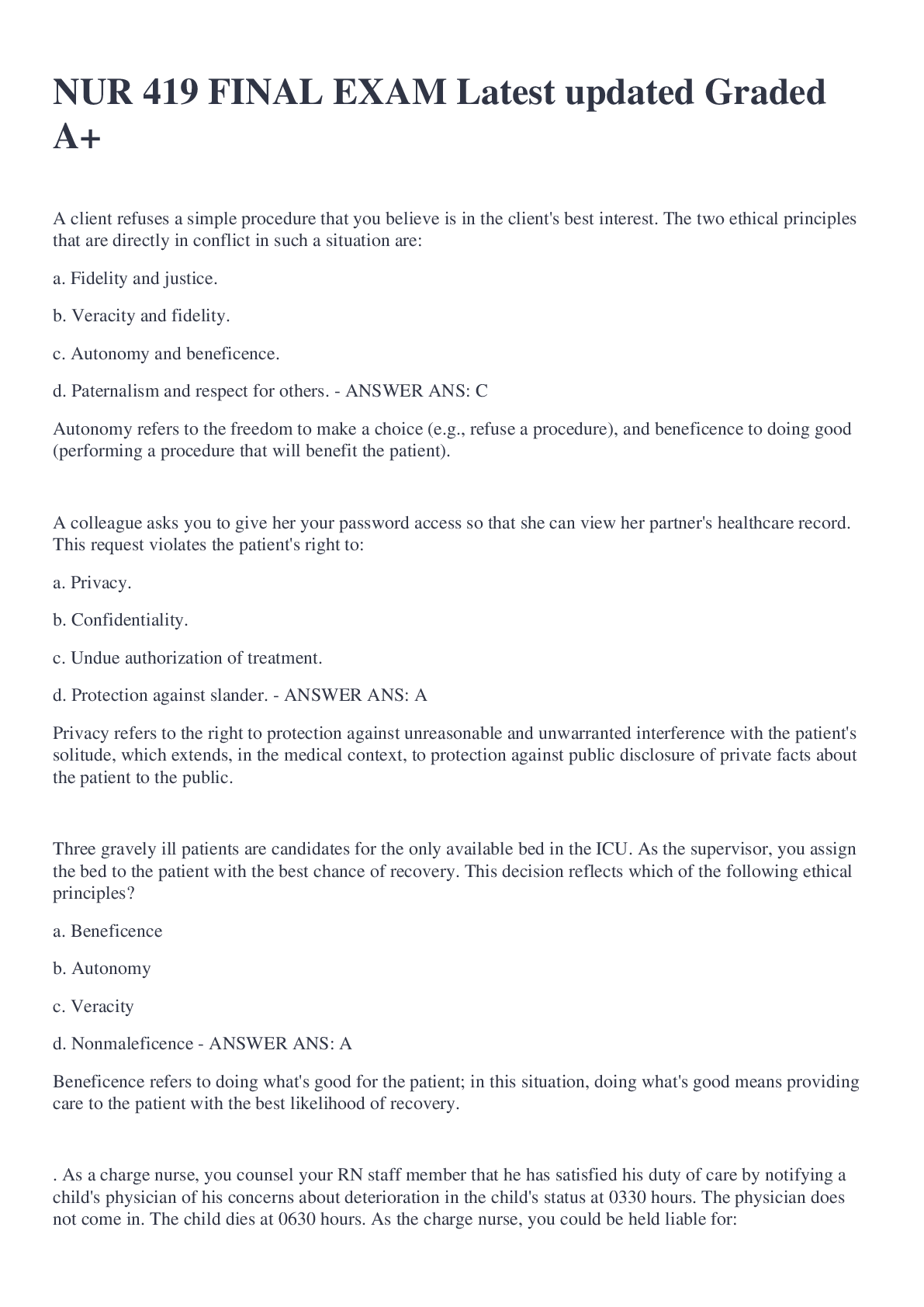Musculoskeletal Exam Latest Updated Graded A+
Document Content and Description Below
The nurse is evaluating the pin sites of a client in skeletal traction. The nurse would be least concerned with which finding? 1.Inflammation 2.Serous drainage 3.Pain at a pin site 4.Purulent ... drainage - ANSWER 2.Serous drainage The nurse has provided instructions regarding specific leg exercises for the client immobilized in right skeletal lower leg traction. The nurse determines that the client needs further teaching if the nurse observes the client doing which activity? 1.Pulling up on the trapeze 2.Flexing and extending the feet 3.Doing quadriceps-setting and gluteal-setting exercises 4.Performing active range of motion (ROM) to the right ankle and knee - ANSWER 4.Performing active range of motion (ROM) to the right ankle and knee A client has sustained a closed fracture and has just had a cast applied to the affected arm. The client is complaining of intense pain. The nurse has elevated the limb, applied an ice bag, and administered an analgesic, which was ineffective in relieving the pain. The nurse interprets that this pain may be caused by which condition? 1.Infection under the cast 2.The anxiety of the client 3.Impaired tissue perfusion 4.The newness of the fracture - ANSWER 3.Impaired tissue perfusion The nurse is assigned to care for a client with multiple traumas who is admitted to the hospital. The client has a leg fracture, and a plaster cast has been applied. In positioning the casted leg, the nurse should perform which intervention? 1.Keep the leg in a level position. 2.Elevate the leg for 3 hours, and put it flat for 1 hour. 3.Keep the leg level for 3 hours, and elevate it for 1 hour. 4.Elevate the leg on pillows continuously for 24 to 48 hours. - ANSWER 4.Elevate the leg on pillows continuously for 24 to 48 hours. A client is complaining of skin irritation from the edges of a cast applied the previous day. The nurse should plan for which intervention? 1.Massaging the skin at the rim of the cast 2.Petaling the cast edges with adhesive tape 3.Using a rough file to smooth the cast edges 4.Applying lotion to the skin at the rim of the cast - ANSWER 2.Petaling the cast edges with adhesive tape The nurse is preparing a list of cast care instructions for a client who just had a plaster cast applied to his right forearm. Which instructions should the nurse include on the list? Select all that apply. 1.Keep the cast and extremity elevated. 2.The cast needs to be kept clean and dry. 3.Allow the wet cast 24 to 72 hours to dry. 4.Expect tingling and numbness in the extremity. 5.Use a hair dryer set on a warm to hot setting to dry the cast. 6.Use a soft-padded object that will fit under the cast to scratch the skin under the cast. - ANSWER 1.Keep the cast and extremity elevated. 2.The cast needs to be kept clean and dry. 3.Allow the wet cast 24 to 72 hours to dry. A client has had skeletal traction applied to the right leg and has an overhead trapeze available for use. The nurse should monitor which area as a high-risk area for pressure and breakdown? 1.Scapulae 2.Left heel 3.Right heel 4.Back of the head - ANSWER 2.Left heel A client has been placed in Buck's extension traction. Which technique provided by the nurse will provide countertraction? 1.Using a footboard 2.Providing an overhead trapeze 3.Slightly elevating the foot of the bed 4.Slightly elevating the head of the bed - ANSWER 3.Slightly elevating the foot of the bed The nurse is caring for a client with diabetes mellitus who is scheduled to have a right below-knee amputation. The nurse assesses which factors that can put this client at risk for amputation? Select all that apply. 1.Psoriasis 2.Bony deformity 3.Limited joint mobility 4.Peripheral neuropathy 5.Peripheral vascular disease 6.History of skin ulcers or previous amputation - ANSWER 2.Bony deformity 3.Limited joint mobility 4.Peripheral neuropathy 5.Peripheral vascular disease 6.History of skin ulcers or previous amputation The nurse has provided instructions to a client with a herniated lumbar disk about proper body mechanics and other items pertinent to low back care. The nurse determines that the client needs further teaching if the client verbalizes which action should be done? 1.Increase fiber and fluids in the diet. 2.Bend at the knees to pick up objects. 3.Strengthen the back muscles by swimming or walking. 4.Get out of bed by sitting straight up and swinging the legs over the side of the bed. - ANSWER 4.Get out of bed by sitting straight up and swinging the legs over the side of the bed. The nurse is reinforcing instructions to a client with osteoporosis regarding appropriate food items to include in the diet. The nurse tells the client that which food item would provide the least amount of calcium? 1.Pork 2.Seafood 3.Sardines 4.Plain yogurt - ANSWER 1.Pork The nurse is caring for a client who has had an open reduction with internal fixation (ORIF) with a posterior approach. The client has been prescribed hip precautions. The nurse plans to implement which activities in the care of the client? Select all that apply. 1.Ensure the client doesn't bend the hips beyond 120 degrees. 2.Ensure the client doesn't sit or stand for long periods of time. 3.Ensure the client engages in rigorous exercise to maintain strength. 4.Ensure the client doesn't cross the legs past the midline of the body. 5.Ensure the client uses assistive/adaptive devices with activities of daily living. - ANSWER 2.Ensure the client doesn't sit or stand for long periods of time. 4.Ensure the client doesn't cross the legs past the midline of the body. 5.Ensure the client uses assistive/adaptive devices with activities of daily living. The nurse is assisting in caring for a client who has sustained a nasal fracture. The nurse monitors for which priority finding specifically related to this injury? 1.Leakage of clear fluid from the nose 2.Inability to breathe through one nare 3.Hematoma formation around the eyes 4.Edema noted around the nose and eyes - ANSWER 1.Leakage of clear fluid from the nose The nurse is caring for a client admitted with fat embolism syndrome (FES). Which are some of the early manifestations of this syndrome? Select all that apply. 1.Fever 2.Dyspnea 3.Petechiae 4.Hypoxemia 5.Tachypnea 6.Decreased level of consciousness - ANSWER 2.Dyspnea 4.Hypoxemia 5.Tachypnea The nurse in the emergency department is caring for a client with a fractured arm. The nurse understands that which item is least likely needed before reduction of the fracture in the casting room? 1.Anesthesia consent 2.Consent for the procedure 3.Administration of an analgesic 4.Explanation of the procedure to the client - ANSWER 1.Anesthesia consent A client has a fiberglass (nonplaster) cast applied to the lower leg. The client asks the nurse when he will be able to walk on the cast. How should the nurse correctly respond to this question? 1.In 24 hours 2.In 48 hours 3.In approximately 8 hours 4.Within 20 to 30 minutes of application - ANSWER 4.Within 20 to 30 minutes of application The nurse has reinforced instructions with the client with a nonplaster (fiberglass) leg cast about cast care at home. The nurse determines that the client needs further teaching if the client makes which statement? 1."I should avoid walking on wet, slippery floors." 2."I'm not supposed to scratch the skin underneath the cast." 3."It's all right to wipe dirt off the top of the cast with a damp cloth." 4."If the cast gets wet, I can dry it with a hair dryer turned to the warmest setting." - ANSWER 4."If the cast gets wet, I can dry it with a hair dryer turned to the warmest setting." The nurse is teaching a client how to walk with a cane. Which information should the nurse include? Select all that apply. 1.The cane is placed on the affected side. 2.A quad-cane provides a narrower base for the cane. 3.The cane should create no more than 30 degrees of flexion of the elbow. 4.The top of the cane should be parallel to the greater trochanter of the femur. 5.A straight leg cane is used if the client only needs minimal support for an affected leg. - ANSWER 3.The cane should create no more than 30 degrees of flexion of the elbow. 4.The top of the cane should be parallel to the greater trochanter of the femur. 5.A straight leg cane is used if the client only needs minimal support for an affected leg. A client who is learning to use a cane is afraid it will slip with ambulation, causing a fall. What should the nurse tell the client to provide greater reassurance? 1.Canes prevent falls, not cause them. 2.The physical therapist will determine if the cane is inadequate. 3.The cane would help break a fall, even if the client does slip. 4.The cane has a flared tip with concentric rings to provide stability. - ANSWER 4.The cane has a flared tip with concentric rings to provide stability. The nurse is caring for a client who has developed compartment syndrome from a severely fractured arm. The client asks the nurse how this can happen. How should the nurse explain compartment syndrome? 1.A bone fragment has injured the nerve supply in the area. 2.An injured artery causes impaired arterial perfusion through the compartment. 3.Bleeding and swelling cause increased pressure in an area that cannot expand. 4.The fascia expands with injury, causing pressure on underlying nerves and muscles. - ANSWER 3.Bleeding and swelling cause increased pressure in an area that cannot expand. The nurse is monitoring a confused older client admitted to the hospital with a hip fracture. Which issues could place the client at increased risk for disturbed thought processes? Select all that apply. 1.Relatives at the bedside 2.Stress from the fracture 3.Eyeglasses left at home 4.Unfamiliar hospital setting 5.Side effects of medications 6.Hearing aid available and in working order - ANSWER 2.Stress from the fracture 3.Eyeglasses left at home 4.Unfamiliar hospital setting 5.Side effects of medications The nurse is repositioning the client who has returned to the nursing unit following internal fixation of a fractured right hip. How should the nurse plan to position the client? 1.Trochanter roll to prevent abduction while turning 2.Pillow to keep the right leg abducted during turning 3.Pillow to keep the right leg adducted during turning 4.Trochanter roll to prevent external rotation while turning - ANSWER 2.Pillow to keep the right leg abducted during turning [Show More]
Last updated: 1 year ago
Preview 1 out of 16 pages
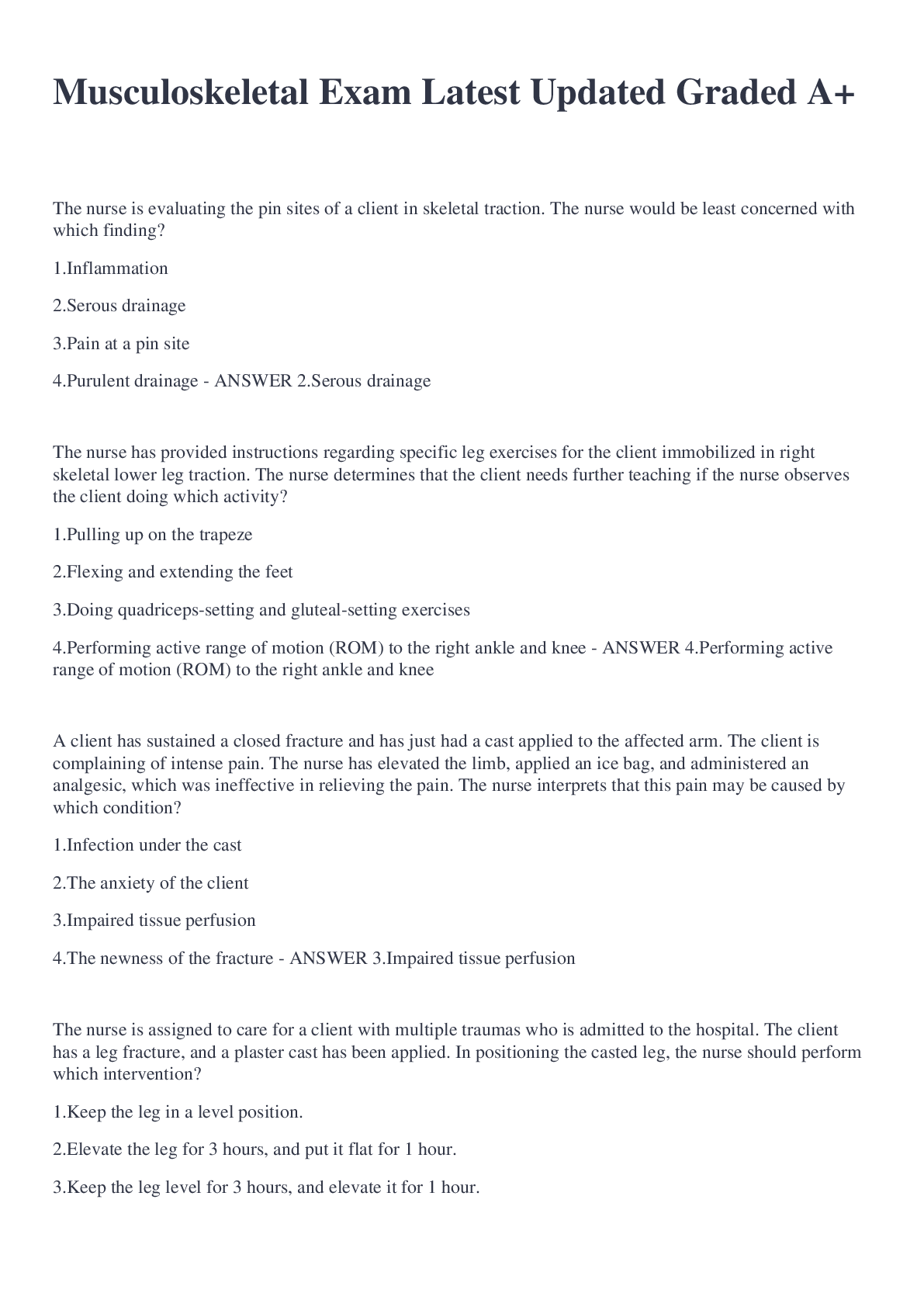
Reviews( 0 )
Document information
Connected school, study & course
About the document
Uploaded On
Nov 15, 2022
Number of pages
16
Written in
Additional information
This document has been written for:
Uploaded
Nov 15, 2022
Downloads
0
Views
253

